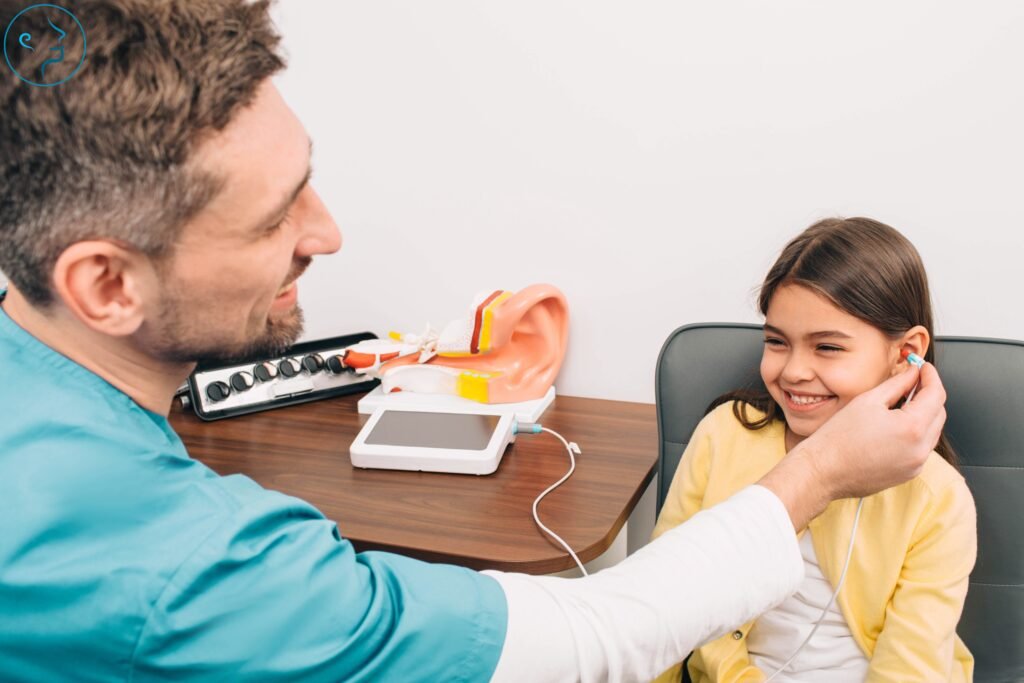
Tympanometry Explained: Your Eardrum’s Secret to Better Hearing Health
Tympanometry is a simple, painless diagnostic test that provides valuable insight into the health and function of your middle ear. Frequently performed as part of a comprehensive ear examination at ENT clinics in Dubai, tympanometry helps detect conditions such as ear infections, hearing loss, and Eustachian tube dysfunction. In this blog, we explore what tympanometry is, how it works, and why it’s essential for accurate diagnosis and treatment.
What is Tympanometry?
Tympanometry measures the movement of your eardrum (tympanic membrane) in response to changes in air pressure. This test helps evaluate the condition of the middle ear and whether there is fluid, infection, or other issues that might impact hearing.
During the test:
- A small, soft probe is gently inserted into the ear canal.
- The probe changes the air pressure while emitting a tone.
- The device records how the eardrum moves in response to these pressure changes and sounds.
The results appear as a graph called a tympanogram, which your ENT specialist in Dubai uses to assess middle ear function.
What Does Tympanometry Measure?
Tympanometry evaluates three key aspects of middle ear health:
- Middle Ear Pressure: Indicates whether the pressure in the middle ear is balanced for optimal hearing.
- Ear Canal Volume: Measures the size of your ear canal, helping detect eardrum perforations or functioning of ear tubes.
- Eardrum Mobility: Assesses how well your eardrum moves; limited or excessive movement can indicate fluid buildup, stiffness, or other structural problems.
Why is Tympanometry Important?
Tympanometry plays a crucial role in diagnosing many ear-related conditions, which are especially common among children and older adults. Here’s why this test is essential:
1. Detecting Middle Ear Infections (Otitis Media)
Middle ear infections are one of the most common causes of ear pain and hearing loss in Dubai—especially in children. Tympanometry helps ENT doctors detect fluid buildup behind the eardrum and start treatment before complications arise.
2. Diagnosing Eustachian Tube Dysfunction
Tympanometry is useful in diagnosing Eustachian tube dysfunction, which can cause ear pressure, muffled hearing, and discomfort—common complaints in people suffering from air travel-related ear issues in Dubai.
3. Evaluating Causes of Hearing Loss
Though tympanometry doesn’t measure hearing directly, it is essential in identifying the cause of conductive hearing loss, such as middle ear fluid, eardrum damage, or ossicular chain stiffness. This helps guide treatment such as hearing loss treatment in Dubai or further ENT evaluation.
4. Assessing the Need for Ear Tubes
In cases of recurrent ear infections or persistent fluid buildup, tympanometry helps determine whether a child or adult might benefit from ear tube insertion, a common procedure at many ENT clinics in Dubai.
5. Monitoring Post-Surgical Recovery
For patients who have undergone ear surgery in Dubai, such as myringoplasty or grommet insertion, tympanometry is a valuable follow-up tool to monitor healing and ensure the middle ear is functioning properly.
Who Should Have Tympanometry?
Tympanometry is often recommended for:
- Children with chronic ear infections
- Adults with ear pain, pressure, or frequent ear blockages
- Patients experiencing sudden or gradual hearing loss
- Post-operative monitoring after ear procedures
If you’re looking for a reliable and professional ENT clinic in Dubai, our experienced team can help assess your ear health using tympanometry and other modern diagnostic tools.
What to Expect During the Test
Tympanometry is quick and painless—typically lasting only a few minutes per ear. You might feel slight pressure changes or hear a soft tone during the test. It’s non-invasive and does not require anesthesia or preparation. Once complete, your ENT doctor in Dubai will review the tympanogram with you and recommend appropriate next steps.
Conclusion: Protect Your Hearing with Tympanometry in Dubai
Tympanometry is an essential diagnostic tool in modern ear care in Dubai, providing accurate insights into middle ear health, especially for patients with ear infections, hearing issues, or pressure imbalance. By detecting problems early, this test helps prevent long-term complications and ensures you get the right treatment.
If you or your child are experiencing ear pain, hearing difficulties, or chronic ear infections, don’t delay. Contact our ENT clinic in Dubai today to schedule a consultation and tympanometry test. We’re here to help you maintain healthy ears and clear hearing.
Its such as you read my mind! You seem to understand so much approximately this, such as you wrote the guide in it or something. I think that you can do with some percent to force the message home a bit, but other than that, this is great blog. An excellent read. I will definitely be back.